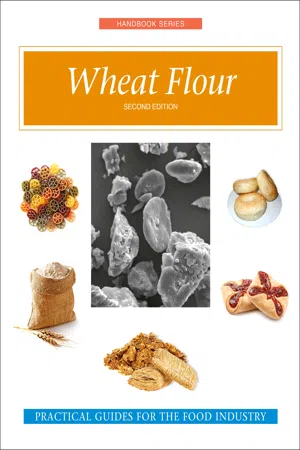
This is a test
- English
- ePUB (mobile friendly)
- Available on iOS & Android
eBook - ePub
Wheat Flour
Book details
Book preview
Table of contents
Citations
About This Book
Wheat Flour
Frequently asked questions
At the moment all of our mobile-responsive ePub books are available to download via the app. Most of our PDFs are also available to download and we're working on making the final remaining ones downloadable now. Learn more here.
Both plans give you full access to the library and all of Perlego’s features. The only differences are the price and subscription period: With the annual plan you’ll save around 30% compared to 12 months on the monthly plan.
We are an online textbook subscription service, where you can get access to an entire online library for less than the price of a single book per month. With over 1 million books across 1000+ topics, we’ve got you covered! Learn more here.
Look out for the read-aloud symbol on your next book to see if you can listen to it. The read-aloud tool reads text aloud for you, highlighting the text as it is being read. You can pause it, speed it up and slow it down. Learn more here.
Yes, you can access Wheat Flour by William A Atwell,Sean Finnie in PDF and/or ePUB format, as well as other popular books in Technology & Engineering & Food Science. We have over one million books available in our catalogue for you to explore.
Information
Chapter 1
Wheat
A wheat seed warms, and moisture begins to penetrate its outer layers. The metabolic processes fostering growth are initiated; a shoot emerges, as does a root, and the seed becomes a fledgling wheat plant. If conditions are favorable, the plant continues to grow, resembling its close cousins, the common grasses found in lawns. The plant continues to grow and, eventually, inside the stem, a head of wheat begins to develop. The stem swells, and then the head emerges. It flowers, initiating the development of new seeds within the head, which ripen from a soft “milky” consistency to kernels that eventually resemble the seed that initiated this entire growth cycle. As the wheat ripens, the plant turns from green to amber and loses moisture.
It is now time to harvest the new wheat kernels by mechanically separating them from the rest of the plant. Perhaps the wheat will be transported to elevators, stored, and transported to larger elevators before the wheat is tempered and milled into flour, or perhaps the kernels will be milled locally. Regardless of where it is milled, this “new crop” flour will eventually be used to produce a seemingly endless variety of wheat-based products.
As the major ingredient in such products, flour exerts a major effect on their quality. To be able to effectively use flour to make high-quality products without encountering processing or end-product quality problems requires a thorough working knowledge of all aspects of wheat and flour. It is the objective of this handbook to be a broad-based resource to aid the reader in acquiring this knowledge.
Historical Perspective
Clearly, wheat was one of the earliest and most widely grown agricultural crops cultivated by humans. It is generally accepted that wheat originated in the Tigris and Euphrates River Valley and that the cultivation of wheat as a food crop probably began between 10,000 and 8000 b.c.e Egyptian tombs 5,000 years old have been unearthed that contain hieroglyphics depicting the harvesting and processing of wheat. Chinese records of wheat date back to 2700 b.c.e. The hardiness of wheat and the variety of food forms that it can take have made it a truly universal part of the human diet.
Wheat Types
The first type of wheat cultivated was einkorn (Triticum monococcum), a diploid wheat containing seven chromosome pairs. Later a 28-chromosome tetraploid wheat known as emmer (T. dicoccum) evolved and was cultivated extensively in the Middle East. Emmer and einkorn are still cultivated and are now referred to as ancient grains. Durum wheat, which is used today to make pasta, is also tetraploid. Common wheat, which is used to make the wide variety of dough and batter-based products today, is hexaploid, having three pairs of each of the seven basic chromosomes.
With respect to biological classification, three species of wheat are most commonly grown today. The first, T. aestivum, forms the classes hard red winter, hard red spring, soft red winter, hard white, and soft white. T. compactum includes the club wheats. The third species is T. durum, which includes the durum and red durum wheat classes.
Table of contents
- Cover image
- Title page
- Table of Contents
- Copyright
- About the AACC International Handbook Series
- Preface
- Chapter 1: Wheat
- Chapter 2: Milling
- Chapter 3: Composition of Commercial Flour
- Chapter 4: Wheat Nutrition
- Chapter 5: Wheat and Flour Testing
- Chapter 6: Specifying “Quality” Flour
- Chapter 7: Products from Hard Wheat Flour
- Chapter 8: Products from Soft Wheat Flour
- Chapter 9: Pasta, Noodle, and Breakfast Cereal Products
- Useful Websites
- Glossary
- Index